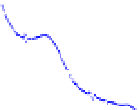Biomedical Engineering Reference
In-Depth Information
alternative extraction routes remain. The improved performance of
both nanoparticle and gyroid devices over nanowires is most likely
due to greater structural stability of the network structure.
February 8, 2010 17:21
(a)
(b)
(c)
6
0.5
40
(tBu)
4
NO
O
O
4
S
0.4
N
H
C
N
N
N
30
Ru
N
2
C
H
N
S
0.3
O
0
(tBu)
4
NO
O
20
0.2
-2
10
0.1
-4
0.0
-6
0
400
450
500
550
600
650
700
750
0.0
0.2
0.4
0.6
0.8
1.0
400
450
500
550
600
650
700
750
Wavelength (nm)
Wavelength (nm)
Voltage (V)
Figure 2.27
DSC solar cell characteristics. 1.2 μm thick nanowire (
),
�
1.2 μm thick gyroid (
arrays. (a)
Absorption spectra after sensitization with N719 (inset). (b) Spectral
response of liquid electrolyte dye-sensitized solar cells. (c) Current-voltage
curves under simulated AM1.5 100 mW cm
▴
), and 1.4 μm thick nanoparticle (
•
) TiO
2
solar illumination. Reproduced
−2
with permission from Ref. [56].
The dynamics of photogenerated electrons in the solid
semiconductor phase has a strong bearing on the operational
efficiency of the solar cell. Ideally, charge should be able to escape
the device as quickly as possible, leaving as short a time as possible
to undergo recombination events with species in the surrounding
electrolyte. Under shortcircuit conditions, measuring the transient
current decay time following an incident light pulse gives a measure
of the time taken for electrons to diffuse out of the array. Assuming the
transport mechanism to be one of multiple trapping and retrapping
events, one would expect a one-dimensional diffusion to progress
three times faster than a three-dimensional diffusion. However,
this argument only applies if the confinement lengthscale is on the
same order as the distance between charge trapping sites. Charge
collection times measured in wire arrays are approximately twice
as fast as in gyroid arrays of the same thickness (Fig. 2.28). That a
full threefold improvement was not observed could be a result of
interwire electrical contacts, or a density of traps greater than one
per nanocrystal, such that a wire cannot be reasonably modeled as
an ideal one-dimensional sequence of trap sites.
















































































































































































































Search WWH ::

Custom Search